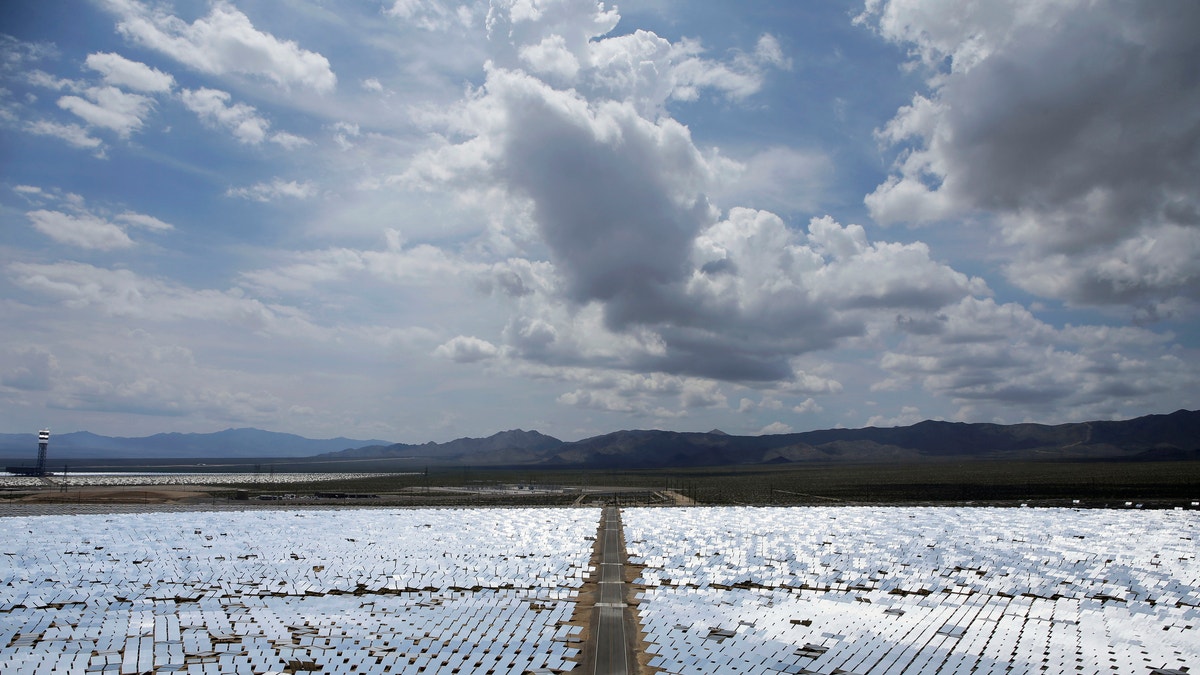
FILE -- This Aug. 13, 2014 photo, shows an array of mirrors at the Ivanpah Solar Electric Generating site in Primm, Nev. (AP Photo/John Locher)
When Energy Secretary Rick Perry directed the Federal Energy Regulatory Commission (FERC) to create a rule aimed at improving the reliability and resilience of our nation’s electricity grid, he said he want to spark a conversation. It turns out that he touched a live wire.
Proponents of the rule say it will fix the failure of wholesale electricity markets to ensure a resilient electric grid. In particular, they say that under current pricing rule, markets do not adequately compensate for power generators – including nuclear generators -- that help make the grid resilient. Opponents call the rule an attempt to distort the market.
What is clear is that potential adversaries of the United States are rapidly improving their ability to launch physical and cyberattacks against the grid. Grid owners and operators are improving the ability of their systems to survive attack, and (if necessary) accelerate the restoration of service. That progress is essential and needs to continue. However, in addition to attacking the grid, adversaries may also attack the fuel supplies on which power generation depends. That challenge is especially significant for natural gas systems. Gas pipelines typically supply fuel to generators on “just in time” basis, rather than having gas stored in significant quantities where generators are located.
Physical attacks on key gas supply systems and catastrophic natural hazards (especially earthquakes) could also cause severe disruptions to electricity generation that is connected to gas delivery systems. And, regardless of cause, the large-scale cutoff of fuel supplies for electric generation could create long duration power outages across multi-state areas. Such outages would jeopardize public health and safety. They would also threaten U.S. national security by disrupting the flow of power to military bases and the surrounding infrastructure on which those bases depend.
A reliable and resilient electric grid depends on having diverse energy sources. If a natural or human-caused event shuts down one type of generation, another can step in to take up the slack.
Simply put, this means not putting all your energy eggs in one basket.
Our use of gas for electricity generation has roughly doubled to 34 percent of our electricity needs since 2002, largely replacing electricity from coal-fired plants. While coal-fired plants keep several months of fuel onsite, gas-fired plants rely on fuel from a pipeline – fuel that would not come if the pipeline is disrupted.
As we depend more on natural gas for electricity generation, natural gas pipelines have come to rely more electricity to function. The growing interdependencies create risks of cascading failures that will directly affect electricity consumers.
Policy choices to favor new renewables and market forces have led to the closure of some nuclear plants early and put others at risk, leaving Americans at greater risk of blackouts. This is because nuclear plants have 18 to 24 months’ worth of fuel in the reactor and are impervious to most extreme weather.
Critics of Perry’s FERC directive say that resilience is poorly defined. Resilience is about minimizing disruptions and resuming normal operations as quickly as possible. This is what happened during recent hurricanes that struck Florida and Texas, and in the latter case the nuclear plant was one of the only large power plants to stay online throughout the event.
When a company is forced to close a nuclear plant it is gone forever. For context, the five nuclear plants that have closed prematurely since 2013 produced about the same amount of emission-free power all of America’s solar plants.
Diversity also keeps electricity prices competitive.
If we rely too much on one source, a sudden rise in fuel prices catapults electricity prices up along with it. While wind and solar don’t need fuel as such, they do require back up from another source when they are not available.
But having a range of generating sources hedges our bets. In addition, fuel prices are a relatively smaller percentage of nuclear plants’ operating costs compared to plants that run on coal or gas.
That’s why I support Secretary Perry’s call to take action now before we lose more nuclear plants that we cannot bring back. At a minimum, we should ensure that our current markets are not putting critical resource diversity at risk without knowing what the impacts are of such a loss.
Our nation’s ability to generate electricity from multiple fuel sources is a strategic and national security imperative that we must protect. Letting the reliability and resilience of America’s electric grid depend solely on market forces that do not take that into account is more than shortsighted – it’s putting our country unnecessarily at risk.
